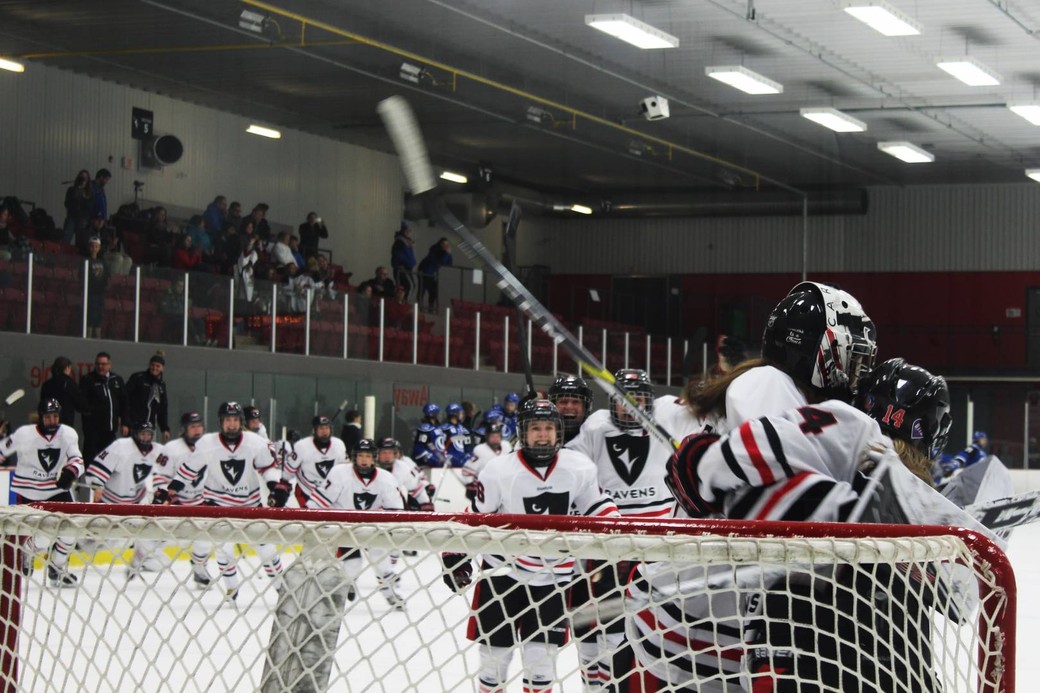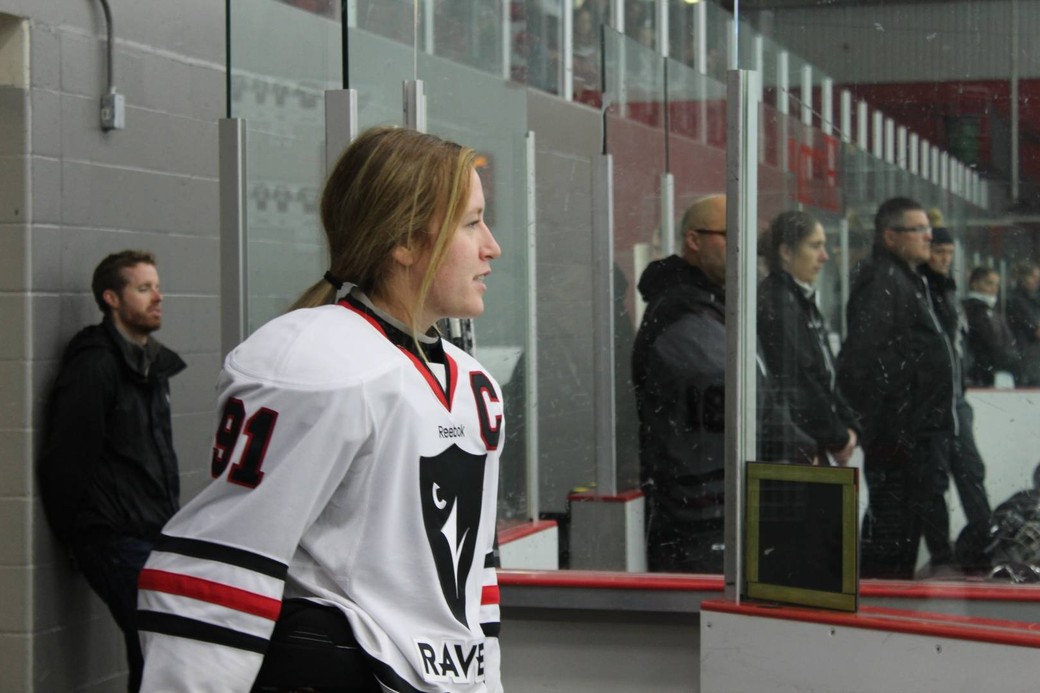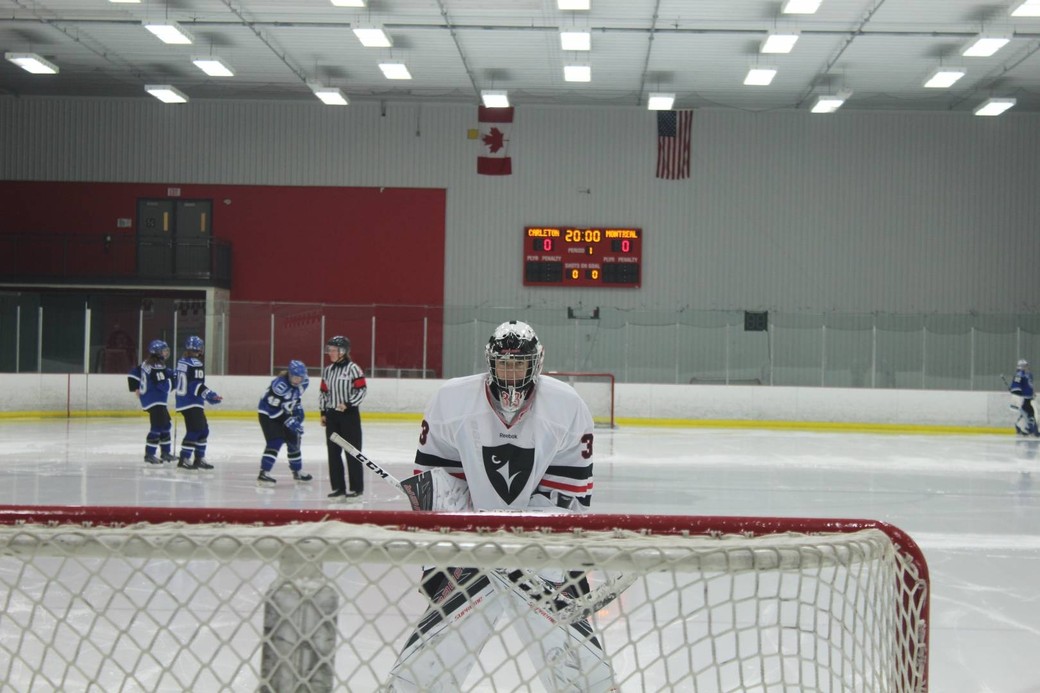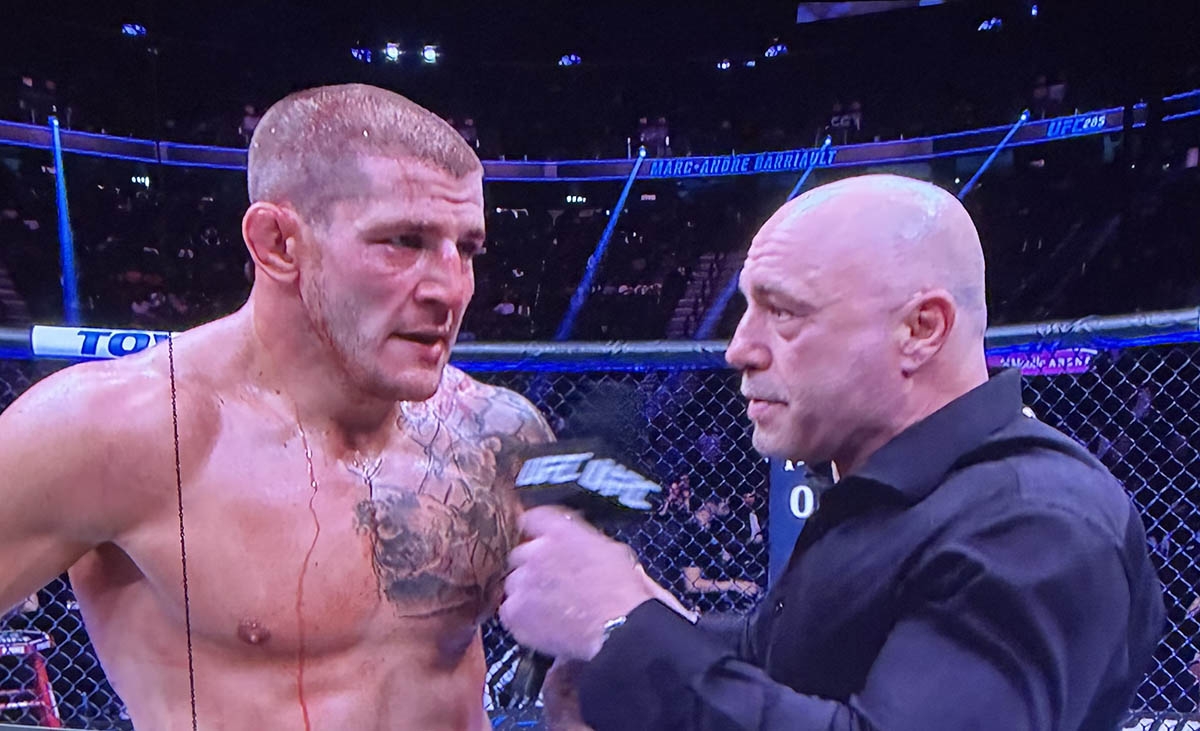
Ravens WHKY: The Turnaround
The Ravens pour off the bench at the final buzzer after beating top-ranked Montreal. All photos by Carlos Verde.
Far from the bright lights and 20,000-seat arena of the National Hockey League’s Ottawa Senators, a team mired in the dilemma of to rebuild or not to rebuild, another capital-region hockey team has already entered a full-swing rebuild.
The Carleton University women’s hockey team is anonymous even on its own campus, but is the most clear-cut example of a traditional rebuild in the Ottawa sports landscape today. Playing their Sunday-afternoon games in front of roughly 100 people at what equates to a community arena, the team is finally showing positive strides in its third year under ambitious head coach Pierre Alain.
There are two critical things to know about the Ravens program: The team has been downright awful for the past three seasons, compiling a 9-47-4 record, and Alain, the architect of the rebuild, is as driven a coach as you will find at any level.
Over the course of last year’s 20-game season, Carleton managed just 21 goals as a team.
On opening weekend this year, the Ravens scored seven goals and beat the defending national champion. This is the story of how they got there.
Alain was hired in May 2014 to take over what was then the worst women’s hockey program in Canada.
Carleton had finished the previous season with just one win, and its .050 win-percentage the lowest mark in Canada. The team had surrendered a nation-high 4.5 goals-per-game.
“I got the job because (Carleton) Athletics believed in me,” said Alain, a Montreal native who has coached at the national level with Hockey Canada. “We know what we need to bring to the table as coaches and staff; recruiting is a big piece of women’s hockey programs coast-to-coast, and you need the players to execute your system.”

Year one proved to be a struggle for Alain’s program as he attempted to change the team’s dressing room culture; the Ravens finished 3-17, and the team recruited just one player of long-term impact.
To initiate a positive change in any locker room, a coach has to rely on respected veterans.
Tawnya Guindon is the longest-serving Raven on this year’s Carleton roster. A fifth-year forward from Clarence Creek, Guindon was a sophomore on Carleton’s historically-bad 2013-14 squad and has since played a major role in reshaping the program’s identity.
“It’s a big difference (from then), you can’t even compare the two,” said Guindon, one of Carleton’s top offensive players. “It’s a big change, we’ve brought in players who have better hockey smarts and skills — players who can actually implement a game plan and follow it to win a game.”
The Clarence Creek native has been through plenty as a Raven; regular seven-goal losses to top-ranked teams, dressing room tension, and ultimately the largest roster shuffle in the program history. Despite that upheaval, Guindon has brought her quiet brand of leadership and an unmatched love for the game to the rink on a daily basis.
“She’s a role model for her teammates (and) her heart is totally committed to this program,” said Alain of Guindon, his team’s captain. “She’s always at the rink — first on the ice, last off the ice — and has put in a tremendous amount of work to become a better player.”
Year two of Alain’s rebuild, 2015-16, was another difficult step in the process; with a dozen new recruits, the young Ravens struggled to a 5-15 record and once again missed the playoffs. However, bright spots like an unlikely upset victory over top-ranked McGill and contributions from a series of first-year players confirmed to the architect that his design was indeed working.
“I’m not a magician, this is a long process that takes hard work and smart work, and I believe we’re doing both,” explained Alain. “When you’re losing badly — 9-0, 8-1 — it’s tough on everybody, both players and coaches. But the plan is to progress every day of every season, and I think we’re doing that.”
One of his best recruiting tools — and one he shares with rival uOttawa — is the city of Ottawa itself.
“It’s a great, bilingual city,” said Alain, who has recruited heavily from his home province of Quebec. “The canal, the river, the downtown, our campus site — it’s all fantastic. There’s a lot of diversity and nice restaurants. Living in Ottawa is fantastic.”
The rest of the women’s hockey scene began to take note of Carleton’s modest progress, and midway through last season the Ravens head coach found himself speaking to players of a higher caliber than before. As more and more commitments fell into place, Alain landed his first blue-chip recruit: Delaney Ross.
The Meadow Lake, Saskatchewan native was named the top player in the JWHL, Western Canada’s premier women’s league, in 2015-16, and her committing to Carleton marked the first big-name prospect landed by the program.
“I love it here,” beamed Ross roughly seven months after her commitment and two months into her Carleton career. “The city is very beautiful, the rink is nice — I don’t have a single bad thing to say about my experience.”
Early in her collegiate debut, she has come as-advertised, notching a goal and an assist in her first two games as a Raven.
“I feel like knowing that Coach Pierre (Alain) coached with Team Canada, and (strength coach) Nick Westcott trained with Team Canada, pushed me here because I knew that he knew what he was doing,” explained Ross, who was recruited by a number of other schools. “I like being the underdog, and coming out here and starting something new is a good challenge.”
Being more than 3,000 kilometres from home in northern Saskatchewan, Ross admits that the move hasn’t always been easy.
“The veterans help a lot, because they’ve been through it all and been coached by Pierre,” admitted Ross, a member of the Canoe Lake First Cree Nation. “Going to them for advice is big for me, especially being so far from home and my family not being at every game.”

Opening weekend 2016 served as an arrival of sorts for the Ravens, who pushed crosstown rivals uOttawa to the brink in a 7-4 loss Saturday before engineering a monumental upset of Montreal, last year’s national champion, Sunday on home ice.
“In terms of a young team, those games are very good for the confidence and team cohesion,” said Alain, whose team had suffered through a series of blowout losses to Montreal over the past two season. “When you bring a new system, those wins are necessary to show the players that what we’re teaching is doable, that it’s possible to have success with what we think is best for our team.”
While the goal for Carleton this season is to make the playoffs and challenge the established power structure of their conference — Montreal and McGill, then everybody else — the real target is 2018-19.
Two seasons from now, the Ravens’ current core group of 20 first- and second-year players will be third- and fourth-years with a plethora of experience. That same group will have developed into leaders and, one would imagine, an incredibly tight-knit locker room group.
Judging by their respectable results to start the season, Carleton is ready to compete now and could turn into a dominant force in its league by 2018.












